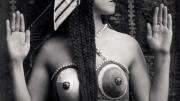Russian ballerina Lubov Tchernicheva, pictured here for a 1920 production of Cleopatra, was ballet mistress of the Ballets Russes in the latter 1920s, and played a vital role in promoting groundbreaking dance movements until her death in 1976. (Her papers are held at Harvard’s Houghton Library.) This sensual shot is among the 73 platinum prints in Emil Hoppé: Photographs from the Ballets Russes, at the Museum of Russian Icons. Also featured are the legendary dancers Vaslav Nijinsky, Adolph Bolm, Michel and Vera Fokine, and Tamara Karsavina—and others who orbited impresario and Ballet Russes founder Sergei Diaghilev.
Hoppé, an internationally renowned photographer of the 1920s and ’30s, fit right in. His London studio drew artists, intellectuals, couturiers, celebrities, literary stars, and members of the royal family. Thus, as the exhibit notes, he captured creative forces and dance performers that “shocked the senses and seduced the world into the modern era.”









